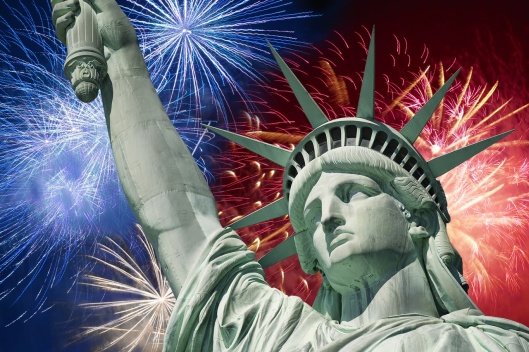
Fireworks behind statue of liberty
Variously known as the Fourth of July and Independence Day, July 4th has been a federal holiday in the United States since 1941, but the tradition of Independence Day celebrations goes back to the 18th century and the American Revolution (1775-83). In June 1776, representatives of the 13 colonies then fighting in the revolutionary struggle weighed a resolution that would declare their independence from Great Britain. On July 2nd, the Continental Congress voted in favor of independence, and two days later its delegates adopted the Declaration of Independence, a historic document drafted by Thomas Jefferson. From 1776 until the present day, July 4th has been celebrated as the birth of American independence, with typical festivities ranging from fireworks, parades and concerts to more casual family gatherings and barbecues.
Many historians believe that Independence Day’s most explosive form of entertainment originated in China, which continues to produce and export more fireworks than any other country in the world. It is thought that, as early as 200 B.C., the Chinese had already stumbled upon a sort of natural firecracker: They would roast bamboo, which explodes with a bang when heated due to its hollow air pockets, in order to ward off evil spirits.
At some point between 600 and 900 A.D., Chinese alchemists—perhaps hoping to discover an elixir for immortality—mixed together saltpeter (potassium nitrate, then a common kitchen seasoning), charcoal, sulfur and other ingredients, unwittingly yielding an early form of gunpowder. The Chinese began stuffing the volatile substance into bamboo shoots that were then thrown into the fire to produce a loud blast. The first fireworks were born.
Soon, paper tubes came to replace the bamboo stalks, and the Chinese discovered that their fiery sticks could be used for more than just scaring away ghosts and celebrating special events. By the 10th century, they had developed crude bombs and begun attaching firecrackers to arrows that rained down on their adversaries during military engagements. Two hundred years later, they learned how to fire explosives into the air and guide them toward enemy targets, essentially building the first rockets. Used outside the field of battle, the same technology allowed fireworks masters to put on the first aerial displays.
The softer side of gunpowder—fireworks—became increasingly popular first to commemorate military victories and later to enhance public celebrations and religious ceremonies. In medieval England, fireworks experts were known as firemasters. Their assistants, called “green men” because they wore caps of leaves to protect their heads from sparks, doubled as jesters, entertaining the crowd with jokes as they prepared the displays.
By the time of the Renaissance, pyrotechnic schools were training fireworks artists across Europe, particularly in Italy, which became famous for its elaborate and colorful displays. It was the Italians who in the 1830s became the first to incorporate trace amounts of metals and other additives, creating the bright, multihued sparks and sunbursts seen in contemporary fireworks shows.
Fireworks gained an especially strong following among European rulers, who used them to enchant their subjects and illuminate their castles on important occasions. Europeans brought their knowledge and appreciation of fireworks to the New World. According to legend, Captain John Smith set off the first display in Jamestown in 1608.
On July 3, 1776, the day before the Continental Congress adopted the Declaration of Independence, John Adams wrote a letter to his wife in which he presaged the role of fireworks in Fourth of July celebrations. “The day will be most memorable in the history of America,” he predicted. “I am apt to believe that it will be celebrated by succeeding generations as the great anniversary festival. It ought to be solemnized with pomp and parade…bonfires and illuminations [a term for fireworks]…from one end of this continent to the other, from this time forward forevermore.”
The following year, fireworks displays commemorated the fledgling country’s first anniversary, just as they have each subsequent one.
